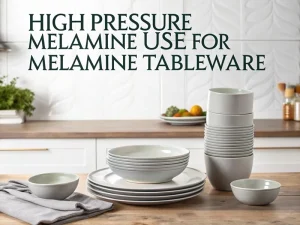
High Pressure Nelamine Use For Melamine Tableware Advantage
Tech Blog High Pressure melamine Use For Melamine Tableware Melamine tableware has become a staple for households, restaurants, and catering services worldwide due to its

When looking for tableware that is both aesthetically pleasing and durable, melamine (also known as melamine resin) products are often the first choice. It is lightweight, colorful, and known for its “unbreakable” characteristics, especially favored by families with children and outdoor enthusiasts.
But for first-time users, a common question always exists: are melamine products easy to break?
The short answer is: Melamine is highly ‘break-resistant’, but not entirely ‘unbreakable’. It can withstand daily collisions and drops that most ceramic or glass tableware cannot resist, but it does have its limits.
Understanding the difference between these two words is crucial.
Break Resistant: This means that melamine tableware typically does not break or crack when dropped from table height onto most household floors, including wooden floors and carpets. This is its most significant advantage over ceramics and glass.
Unbreakable: This means that the material will not break under any circumstances. Melamine does not belong to this category. It will still be damaged when subjected to sufficient force or specific types of impact.
Yes, melamine can break, but it is much harder to break than ceramics, glass, or porcelain.
The durability of melamine has its limits. Although it can withstand minor impacts, extreme external forces (such as falling from a height onto hard ground, such as concrete) may cause it to crack, fall, or even shatter. Thick, high-quality melamine products (such as restaurant-grade products) are more durable than lightweight, inexpensive products, but no melamine product is completely unbreakable.
Although melamine is very strong, it is not indestructible. The following are several situations that may cause damage:
Intense and concentrated impact: If a melamine dish hits a rigid surface (such as a tile, cement floor, or granite countertop) at a very sharp angle (e.g., an edge), it may crack or chip. It usually does not “explode” into many sharp, small fragments like glass, but rather tends to show a crack or a gap.
Extreme thermal shock: Melamine should never be used in microwave ovens. Microwaves heat the resin itself, not the food, which can cause the material to overheat, dry out, become brittle, and ultimately crack and foam. This not only damages tableware but may also pose a safety hazard.
Long-term use and aging: After years of frequent use and dishwasher cleaning, the toughness of melamine may slightly decrease, making it more susceptible to impact damage than when new.
Handle with care: Avoid dropping melamine products onto hard surfaces, especially from high places.
Avoid sudden temperature changes: Place hot food in a melamine container after it has cooled slightly, and do not use it to hold boiling water.
Gentle cleaning: Use a soft sponge and a mild cleaner; avoid using steel wool or abrasive cleaners, as they can scratch the surface.
Choose high-quality products: Identify thick, restaurant-grade melamine (check if the label has FDA, LFGB, or other “food contact safety” certifications).
Proper storage: Leave gaps when stacking to avoid crushing and cracking, and do not stack heavy objects on top of one another.
Although it is durable, you should consider replacing it when you see the following signs:
Cracks or gaps appear: Damaged areas may harbor bacteria and are no longer safe.
There are deep scratches on the surface; similarly, they are tricky to thoroughly clean.
Appearance of uncleanable stains or loss of surface gloss:This indicates that the protective layer has worn out.
Melamine is not unbreakable, but it is indeed much more resistant to breakage than ceramics, glass, or porcelain. Its durability makes it an ideal choice for high-frequency use and leisure scenes, but it may still crack or fall under extreme stress, sudden temperature changes, or long-term wear and tear.
By choosing high-quality products and taking good care of them, you can enjoy the lightweight advantage of melamine while reducing the risk of breakage. If extreme drop resistance is required (such as camping), stainless steel may be more suitable—but in daily use, melamine offers an excellent balance between durability and practicality.

Tech Blog High Pressure melamine Use For Melamine Tableware Melamine tableware has become a staple for households, restaurants, and catering services worldwide due to its

Tech Blog Melamine packaging For manufacturers, inaccurate packaging not only fails to meet national standards but also increases labor costs and the risk of product

Tech Blog How to Detect Melamine in Textiles? Melamine powder, a nitrogen-containing heterocyclic compound, is widely used in flame-retardant textiles and plastic products due to

JINGJIANG MELAMINE POWDER
© JINJIANG MELAMINE